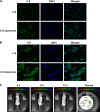Synergistic apoptotic effects of apigenin TPGS liposomes and tyroservatide: implications for effective treatment of lung cancer
- PMID: 28761344
- PMCID: PMC5522679
- DOI: 10.2147/IJN.S140096
Synergistic apoptotic effects of apigenin TPGS liposomes and tyroservatide: implications for effective treatment of lung cancer
Abstract
To develop an alternative treatment for lung cancer, a combination of two potent chemotherapeutic agents - liposomal apigenin and tyroservatide - was developed. The therapeutic potential of this combination was investigated using A549 cells. Apigenin and tocopherol derivative-containing D-alpha-tocopheryl polyethylene glycol 1000 succinate (TPGS) liposomes might improve the delivery of apigenin to tumor cells, both in vitro and in vivo. Importantly, compared to either agent alone, the combination of apigenin TPGS liposomes and tyroservatide exhibited superior cytotoxicity, induced stronger G2 arrest, and suppressed A549 cancer cell invasion at a lower dose. The proapoptotic synergistic effects were also observed in A549 cells using terminal deoxynucleotidyl transferase-mediated dUTP nick-end labeling, flow cytometry, and Western blot analysis. More importantly, in vivo results showed that the combination of apigenin TPGS liposomes and tyroservatide exhibited tumor-growth inhibitory effects in A549 cell-bearing mice. In conclusion, our study showed that this combination therapy could serve as a promising synergistic therapeutic approach to improve outcomes in patients with lung cancer.
Keywords: TPGS liposomes; apigenin; apoptosis; synergistic antitumor; tyroservatide.
Conflict of interest statement
Disclosure The authors report no conflicts of interest in this work.
Figures







Similar articles
-
Tyroservatide-TPGS-paclitaxel liposomes: Tyroservatide as a targeting ligand for improving breast cancer treatment.Nanomedicine. 2017 Apr;13(3):1105-1115. doi: 10.1016/j.nano.2016.10.017. Epub 2016 Nov 12. Nanomedicine. 2017. PMID: 27845234
-
Dual drug loaded liposome bearing apigenin and 5-Fluorouracil for synergistic therapeutic efficacy in colorectal cancer.Colloids Surf B Biointerfaces. 2019 Aug 1;180:9-22. doi: 10.1016/j.colsurfb.2019.04.035. Epub 2019 Apr 16. Colloids Surf B Biointerfaces. 2019. PMID: 31015105
-
Preparation and antitumor evaluation of self-assembling oleanolic acid-loaded Pluronic P105/d-α-tocopheryl polyethylene glycol succinate mixed micelles for non-small-cell lung cancer treatment.Int J Nanomedicine. 2016 Nov 28;11:6337-6352. doi: 10.2147/IJN.S119839. eCollection 2016. Int J Nanomedicine. 2016. PMID: 27932881 Free PMC article.
-
Drug Delivery Innovations for Enhancing the Anticancer Potential of Vitamin E Isoforms and Their Derivatives.Biomed Res Int. 2015;2015:584862. doi: 10.1155/2015/584862. Epub 2015 Jun 7. Biomed Res Int. 2015. PMID: 26137487 Free PMC article. Review.
-
Copolymers of poly(lactic acid) and D-α-tocopheryl polyethylene glycol 1000 succinate-based nanomedicines: versatile multifunctional platforms for cancer diagnosis and therapy.Expert Opin Drug Deliv. 2013 Apr;10(4):529-43. doi: 10.1517/17425247.2013.758632. Epub 2013 Jan 14. Expert Opin Drug Deliv. 2013. PMID: 23316695 Review.
Cited by
-
Vitamin E Oil Incorporated Liposomal Melphalan and Simvastatin: Approach to Obtain Improved Physicochemical Characteristics of Hydrolysable Melphalan and Anticancer Activity in Combination with Simvastatin Against Multiple Myeloma.AAPS PharmSciTech. 2021 Dec 14;23(1):23. doi: 10.1208/s12249-021-02177-6. AAPS PharmSciTech. 2021. PMID: 34907484
-
Anti-inflammatory activities of flavonoid derivates.ADMET DMPK. 2023 Jul 26;11(3):331-359. doi: 10.5599/admet.1918. eCollection 2023. ADMET DMPK. 2023. PMID: 37829324 Free PMC article. Review.
-
Preparation of Liposomal Raloxifene-Graphene Nanosheet and Evaluation of Its In Vitro Anticancer Effects.Dose Response. 2022 Jan 12;20(1):15593258211063983. doi: 10.1177/15593258211063983. eCollection 2022 Jan-Mar. Dose Response. 2022. PMID: 35069050 Free PMC article.
-
TPGS-Modified Long-Circulating Liposomes Loading Ziyuglycoside I for Enhanced Therapy of Myelosuppression.Int J Nanomedicine. 2021 Sep 14;16:6281-6295. doi: 10.2147/IJN.S326629. eCollection 2021. Int J Nanomedicine. 2021. PMID: 34548791 Free PMC article.
-
Preparation, characterization and antitumor activity evaluation of apigenin nanoparticles by the liquid antisolvent precipitation technique.Drug Deliv. 2017 Nov;24(1):1713-1720. doi: 10.1080/10717544.2017.1399302. Drug Deliv. 2017. PMID: 29115900 Free PMC article.
References
-
- Siegel RL, Miller KD, Jemal A. Cancer statistics, 2017. CA Cancer J Clin. 2017;67(1):7–30. - PubMed
-
- Tangutur AD, Kumar D, Krishna KV, Kantevari S. Microtubule targeting agents as cancer chemotherapeutics: an overview of molecular hybrids as stabilising and destabilising agents. Curr Top Med Chem. 2017 Jan 4; Epub. - PubMed
-
- Wijdeven RH, Pang B, Assaraf YG, Neefjes J. Old drugs, novel ways out: drug resistance toward cytotoxic chemotherapeutics. Drug Resist Updat. 2016;28:65–81. - PubMed
-
- Papadas A, Asimakopoulos F. Mechanisms of resistance in multiple myeloma. Handb Exp Pharmacol. 2017 Mar 18; Epub. - PubMed
MeSH terms
Substances
LinkOut - more resources
Full Text Sources
Other Literature Sources
Medical

